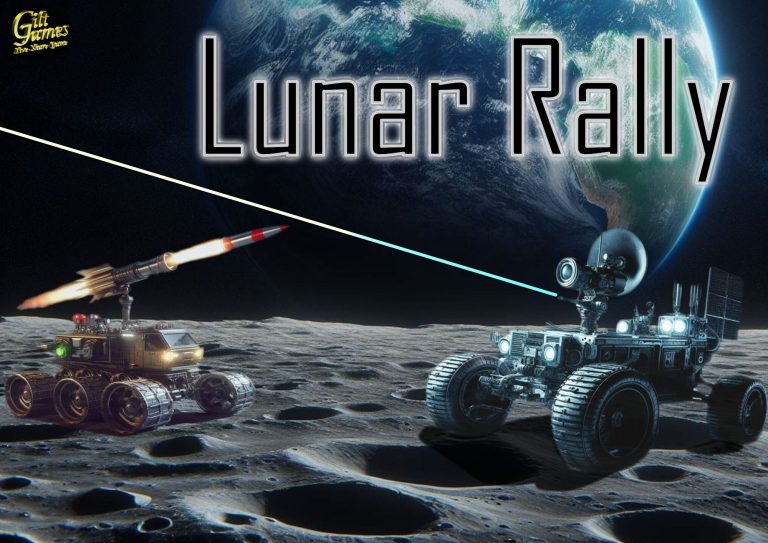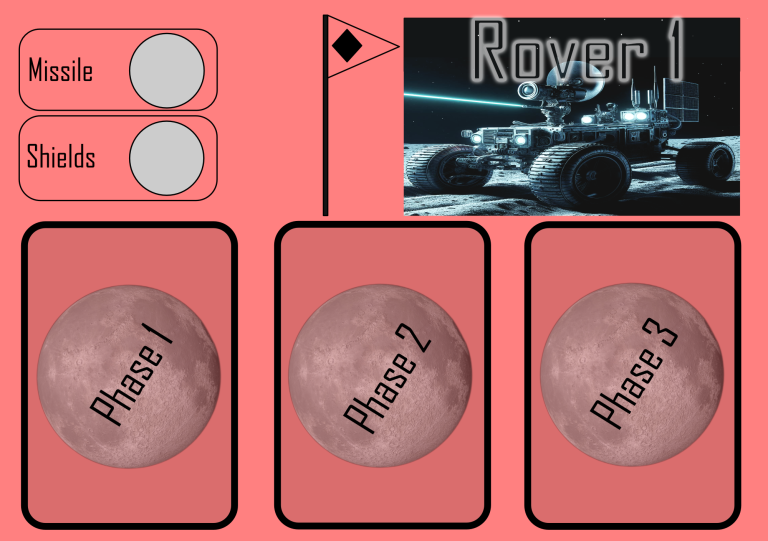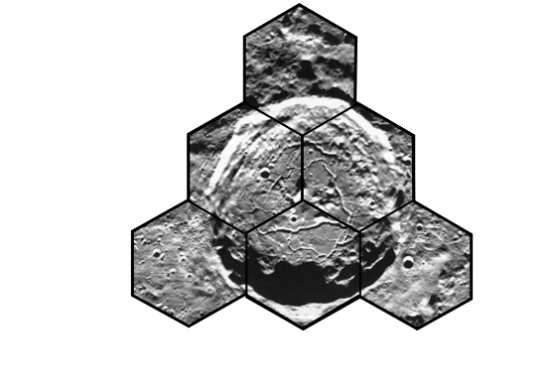Lunar Rally

Race Lunar Rovers around the moon.
Be the first to the finish line. Avoid the craters and navigate the dust.
Beware the lasers and missiles on the other Rovers!
A racing game for 2-4 players
Time to Play - 45 to 90 minutes
Age 14+
Prototype is complete - seeking a publisher
Introduction
You two Rovers in a Race across the lunar surface.
but...
you control them from earth, so there is a delay between sending the instructions to the rovers and their execution.
a game of skill and anticipation
Gameplay




Players send instructions to their Rovers using the Control Cards.
Players programme their Rover 1s simultaneously, then apply the Rover 2s instructions, reprogramme Rover 2s, then apply the Rover 1s instructions. The delay in execution means that the board has changed.
Each rover is controlled using a deck of 8 cards, and up to 3 instructions can be sent each turn. If a rover is damaged, it will start to lose phases and become slower and less manoeuvrable.
rovers are armed with lasers, which fire straight forwards and have unlimited uses, and with missiles that select a target ahead of them. missiles are used when fired, but replacements can be picked up during the rally.
rovers can also ram each other to do damage.
it is quite possible to damage your other rover.
The board is modular and either 2 or 3 sections can be used. Craters and Fine Dust are added to produce hazards that the Rovers must navigate, and Caches and Repair Stations can be used to repair and replenish.
The game includes 4 suggested scenarios, but players can create their own.

Rules
Introduction
Lunar Rally is a game for 2 – 4 players. Depending on the scenario and number of players it can take between 30 and 90 minutes.
The aim of the game s to get one of your two Rovers to the Finish Line first. Sounds easy?
The Rovers race on the Moon but are controlled from Earth, so there is a delay between you sending an instruction to the Rover and it executing. To make things more interesting, the Rovers are armed with lasers and missiles and a heavily damaged Rover is slower and more difficult to control,
Each player controls two Rovers. Rover 1 is slightly lighter and faster, and Rover 2 is slightly better armed and can go into reverse.
Game Components
1 x Rules
1 x Board (in three sections)
4 x Scenario Maps (2 pages each with 2 sides)
8 x Control Boards (One for each Rover. Each control board is made up of 3 sections)
8 x Decks of 8 Instruction Cards (One for each Rover)
8 x Uprights (One for each Rover)
7 x Craters (2 x 7 hexes, 2 x 6 hexes. 2 x 3 hexes. 2 x 1 hex)
6 x Fine Dust (3 x 6 hexes, 3 x 3 hexes)
1 x Start Line (in 4 pieces)
1 x Finish Line (in 4 pieces)
6 x Repair Station hexes
24 x Missile Tokens (2 spare)
14 x Shield Tokens (2 spare)
2 x Start Tokens (2 sides, 2 colours per side)
1 x Moon Token
Setting Up
Control Boards and Decks
Each player takes a colour.
Each player has a Control Board for both Rover 1 and Rover 2. At the start of the game, the Control Board should have all 3 phases.
Add Missile Tokens and Shield Tokens to the Control Boards as indicated by the circles. Rover 1s have 1 missile and 1 shield. Rover 2s have 2 missiles and 2 shields.
Each player takes both Decks of Instruction Cards for their colour. One Deck is for Rover 1 and the other for Rover 2. The Decks are marked as Rover 1 and Rover 2. They should not be mixed up.
NB: The Rover 1 and Rover 2 Decks are slightly different. The Rover 1 Decks have 3 x Forward 1 Instruction Cards. Rover 2 decks have 2 x Forward 1 instruction Cards and 1 x Reverse Instruction Card.
Scenario Map
The players select a Scenario Map, ideally by agreement and if that fails, the start tokens can be used. Throw both Start Tokens. One colour will appear on both tokens and select the map with that colour. It is recommended that in a game with less experienced players, either the Blue or the Green scenario is used. The Blue Scenario Map does not use the middle section of the board. (Experienced players are free to vary the scenarios or devise their own.)
Place the green Start Line and the chequered Finish Line as indicated by the chosen Scenario Map.
Place Craters, Fine Dust, Repair Stations and Caches (Missile Tokens) as indicated by the Scenario Map.
Rover Placement
Throw the Start Tokens. The player whose colour is shown the most (2 is the max). Throw again if it is a draw,
Rovers must face off the Start Line, not along it, and the first move should take them closer to the Finish Line.
The first player places their Rover 1 Upright on the Start Line. Placement continues to the left until all players have placed Rover 1. The last player to place Rover 1 places their Rover 2 Upright and placement continues to the right until all players have placed both Rovers.
Initial Programming
NB: Weapons on a Rover do not activate until that Rover has moved off the Start Line.
Each player programmes both Rovers, by putting down three Instruction Cards on each Control Board, one for each Phase. The Rover 1 Deck must be used on Rover 1 and the Rover 2 Deck on Rover 2.
Moon Token
Make sure the Moon Token shows Rover 1 actions.
Turns
Summary
Execute instructions for all Rover 1’s
Reprogramme Rover 1’s
Execute instructions for all Rover 2’s
Reprogramme Rover 2’s
Execution of Instructions
All players move at the same time.
All Rover 1’s move at the same time. When that is completed and Rover 1’s are reprogrammed, After the reprogramming of Rover 1, all Rover 2’s move at the same time, then are reprogrammed.
Phase 1 is resolved, then Phase 2 and finally Phase 3. As the game progresses and Rovers become damaged, they lose the ability to act in later Phases.
In each Phase, the Instruction Card is executed. In many cases, it does not matter which Rover is moved on the board first, but if Rovers interact it can be important. The order that instructions are executed in is:
1. Turn
2. Move
3. Laser
4. Missile
If a Rover explodes (see damage), that happens immediately after the action that caused it to explode.
An Instruction Card from the wrong Deck does not do anything.
NB – Make sure you use the Rover 1 Deck to programme Rover 1 and vice versa.
Reprogramming
After all actions in a turn have been executed and the effects determined, the Rover that has just moved is reprogrammed by placing Instruction Cards on all Phases present on the Control Board for that Rover. Each Instruction Card can only be used once in a turn but can be reused in subsequent turns. Multiple copies of the same Instruction Card can be used in the same turn if they are in the Deck, ie each Deck contains at least two Forward 1 Instruction Cards and both can be used in one turn (if the Rover has enough Phases left).
NB A Rover is reprogrammed after it executes its own instructions and before the other Rover’s instructions are executed, so the board will have changed by the time the programmed actions execute.
Change of Rover
After Rover 1 has been programmed, flip the Moon Token to show Rover 2 actions and proceed to execute Rover 2 instructions.
Conversely, after Rover 2 has been programmed, flip the Moon Token to show Rover 1 actions and proceed to execute Rover 1 instructions.
Moves and Turns
Moves - All moves are 1 hex.
Turns - All turn instructions turn the Rover 60˚ (1 hex face). The Rover turns in the hex without moving.
Collisions - A Rover that hits another Rover while going forwards does 1 damage to the Rover it hits. This includes your other Rover. A Rover that is hit is pushed on 1 hex if that hex is empty. If the hex has another Rover or a Crater in it, or is off the board, then neither the Rover hit, nor the Rover attempting to go forwards, move. Rovers may be pushed onto Caches, Fine Dust or Repair Stations. A Rover 2 that reverses into another Rover pushes it in the same way but does not do damage to it.
Trying to enter the same hex at the same time - A hex can only contain one Rover at a time. If two Rovers try to enter a hex at the same time, neither moves. If a Rover trying to enter a hex is going forwards, it does 1 damage to the other Rover.
Craters - Rovers cannot move into Craters or off the board. If the move as instructed would do that, the Rover does not move and takes 1 damage instead.
Fine Dust - Only one of the Forward 1 Instruction Cards – the Forward 1 - All Terrain Instruction Card - can be used to move onto, over or off Fine Dust. If the other card is used then the Rover does not move. Reverse will not move a Rover 2 onto, over or off Fine Dust.
Weapons
NB – Weapons do not activate until a Rover has moved off the Start Line.
If a Rover tries to execute a Fire Laser or Fire Missile instruction Card before moving off the Start Line, the instruction does nothing. However, weapons remain active even if the Rover moves back onto the Start Line later in the game.
Lasers - Lasers fire straight forwards. The laser can be used an unlimited number of times (but only once per turn as there is only one Fire Laser Instruction Card in each Deck). Lasers hit the closest Rover straight ahead of the firing Rover (this includes the player’s other Rover). Lasers do not pass over Craters but do pass over Fine Dust. A laser does 1 damage.
Missiles – A Rover may only fire a missile if it has a Missile Token, and on executing the Fire Missile Instruction Card the Missile Token is discarded, regardless of whether the missile hits a target. Missiles have a range of 5 hexes and can only travel in the 120˚ arc ahead of the Rover. A missile will hit:
the closest Rover ;
If there are two Rovers equally close, the missile hits the one that is nearer to straight forwards;
If there are two equidistant targets at equal angles or there is nothing within range, the missile misses.
A missile that hits a Rover does 1 damage.
A missile can hit the launching player’s other Rover.
If a Rover tries to execute a Fire Missile Instruction Card but has no Missile Token, the instruction does nothing.
NB – Weapons fire forwards, so a Rover in the lead may be vulnerable to attacks from behind but be unable to retaliate.
Damage
A Rover takes 1 point of damage in the following circumstances:
The Rover is hit by another Rover moving forwards
The Rover tries to enter a hex that another Rover is also trying to enter by moving forwards
The Rover hits a Crater or tries to leave the board.
The Rover is hit by a missile
The Rover is hit by a laser.
The Rover is in an adjacent hex to a Rover that explodes.
Damage is applied immediately (eg a Rover that is rammed applies the damage effect before the laser fire for that Phase).
When a Rover takes damage, it loses a Shield Token if it has one. If it has no Shield Token the Rover loses a Phase. The Phase is removed from the Control Board (and any card that is on the Phase goes back into the Deck). Phase 3 is removed first, then if the Rover takes further damage, Phase 2 is removed. A Rover that has lost a Phase due to damage cannot act in that Phase. Phases that have been lost do not come back unless the Rover is repaired at a Repair Station.
NB - Rovers will slow down as the game progresses.
Explosions - If the Rover takes further damage when it only has Phase 1 remaining, it explodes, doing 1 damage to all Rovers in adjacent hexes.
Caches and Repair Stations
There are Caches of missiles and Repair Stations on the course.
Caches (Missile Tokens on the Board) - If a Rover reaches a Cache (which is simply the name for a Missile Token placed on the Board at the start of the game), it can pick up the Missile Token by using the Still Instruction Card. The Rover must be on the hex containing the Missile Token for the Still Instruction Card to have this effect. The Missile Token is taken off the map and placed on the Rover. If the Rover already has a full complement of missiles (1 for Rover 1, 2 for Rover 2) then the Missile Token is not picked up. Once a Missile Token has been picked up, it is not available for pickup again.
Repair Stations – If a Rover uses the Still Instruction Card when it is on a Repair Station then it will repair a Phase, or if it already has all its Phases, it will add a Shield Token. If the Rover already has a full complement of shields (1 for Rover 1, 2 for Rover 2) then the repair has no effect.
Winning
The winner is the first player whose Rover reaches (moves onto) the Finish Line. If more than one Rover does so simultaneously, the race is a tie between them. If all Rovers are destroyed, the game is a draw between all players.
It is open to players to concede at any time.
It would be an unusual game if all (or indeed most) players still had two Rovers at the end.
© Copyright Proprietor of Gilt Games. All rights reserved.
We need your consent to load the translations
We use a third-party service to translate the website content that may collect data about your activity. Please review the details in the privacy policy and accept the service to view the translations.





